As agreed, early in the morning we transferred by taxi from Kochi to Alappuzha. There we embarked on a small ship, but before the ship left the pier, I went to a nearby shop where I bought some fruit for the day and I also made a phone call in order to book accommodation for us in Varkala.
The taxi ride to Alappuzha was completely nerve-racking, in addition to which already that early in the morning it was incredibly hot while the air humidity did not go down at any point. While I was buying the fruit from the stalls in front of the shop, since there was traffic jam in the street, there were several vehicles including a couple of lorries standing practically beside me and they all used such loud horns that it was completely ear-splitting. Because of all of this, I became incredibly hysterical. All of my nerves and senses were probably additionally susceptible since the day before I started to develop something like a flu.
Namely, after a couple of problems with my stomach (Panaji) and my intestines (Mysore), that part of my body calmed down completely. However, now I started to have problems with my respiratory section and, unfortunately, that would continue to bother me throughout the rest of my stay in India and to such a degree that the last evening I even had high temperature. No wonder that by that time I could hardly wait to get back home completely convinced that I would never want to return to India. Luckily, a very specific combination of circumstances brought me back to this incredible country five years later and now, when I recollect my 2007 journey it is with joy and renewed admiration for all the places I visited and all the things I saw back then.
On this day, after that initial terrible noise, I went back to the ship and as soon as it started to move it was a whole different story.
The cities of Alappuzha and Kollam situated in the federal state of Kerala are around 90 km one from the other and they are connected by a road and by a railway line. Sneža and I, however, decided to cover the distance by ship which is mostly earmarked for tourists and local visitors.
By the way, Alappuzha, like many other cities we had already been to, has another name which is used in parallel – Alleppey. As a reminder – previously we had already been to Panaji/Panjim, Mysore/Mysuru and Kochi/Cochin. Rather confusing, isn’t it?
So, once the boat left the pier, it soon got to the main watercourse that flowed in the direction of Kollam. Needless to say, this was a somewhat bigger vessel than the one we were on the previous afternoon and this time it was a far cry from hearing only the birds – this vessel did have its proper engine – but it was nonetheless a nice and comparatively quiet journey.
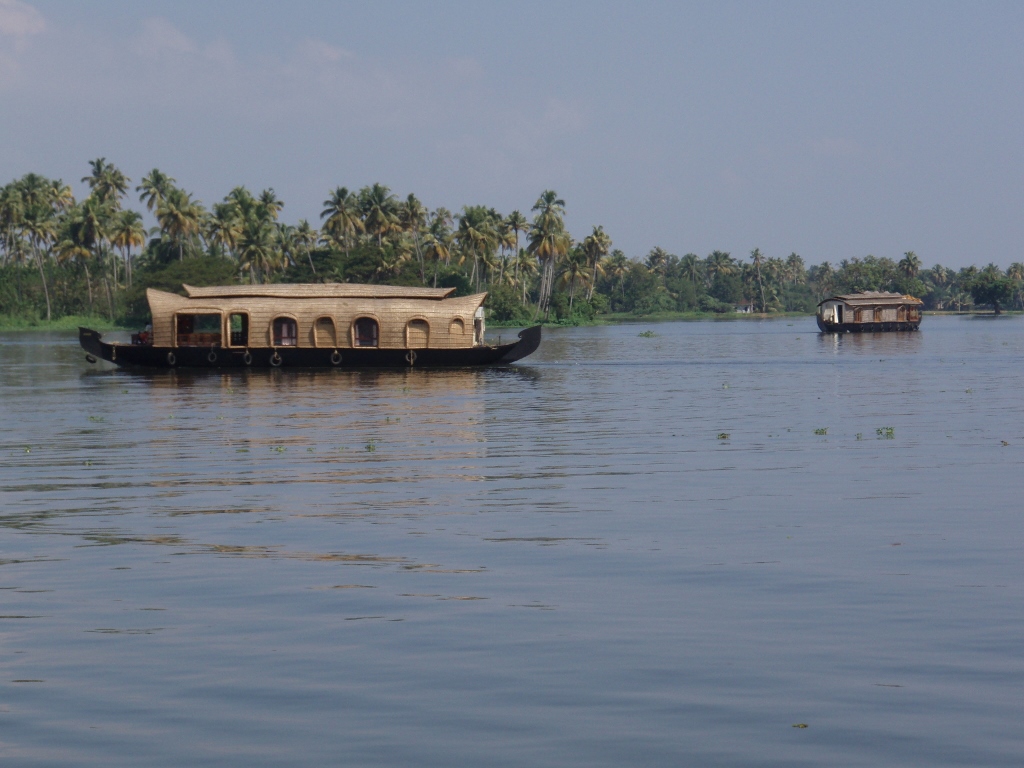 Backwaters in Kerala
Backwaters in Kerala
By the way, the boats that can be seen in the photo above and the one we sailed on the previous afternoon are called kettuvallam. These are house boats which were used in the past for the transportation of people and goods, but are nowadays mostly used in tourism. The one we were on the afternoon before was a quite simple version of this vessel and it was intended only for daily excursions, but there are also those that indeed have a small house on them in which it is possible to stay.
We spent around eight hours this day in this laid-back navigation and sometimes it seemed as if it were too much, but it was basically very nice indeed. Most of the day we spent sitting on the ship’s terrace with our feet up cosily resting on the ship’s fence, while the wonderful images kept replacing one another in front of our eyes.
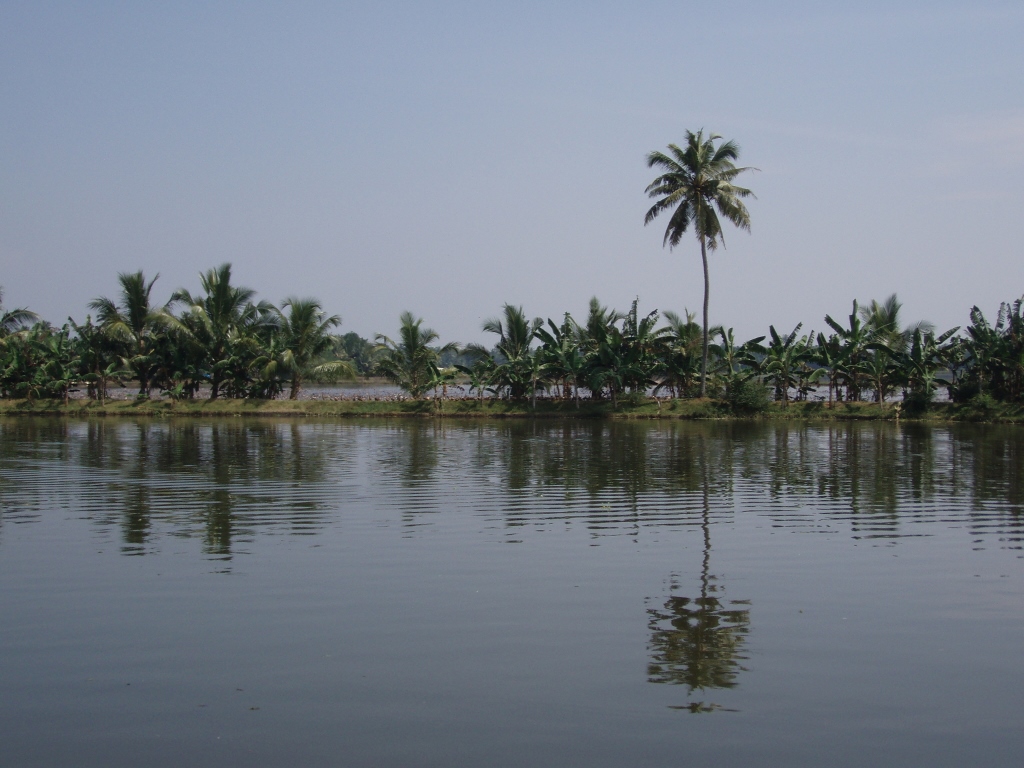 Water is in the front and water is in the back, while in-between there is a thin strip of land with bananas and palm trees
Water is in the front and water is in the back, while in-between there is a thin strip of land with bananas and palm trees
Irrespective of the roads and the railway line that exist, these waterways in Kerala are used to a large degree even today. We saw particularly frequently transportation of agricultural products.
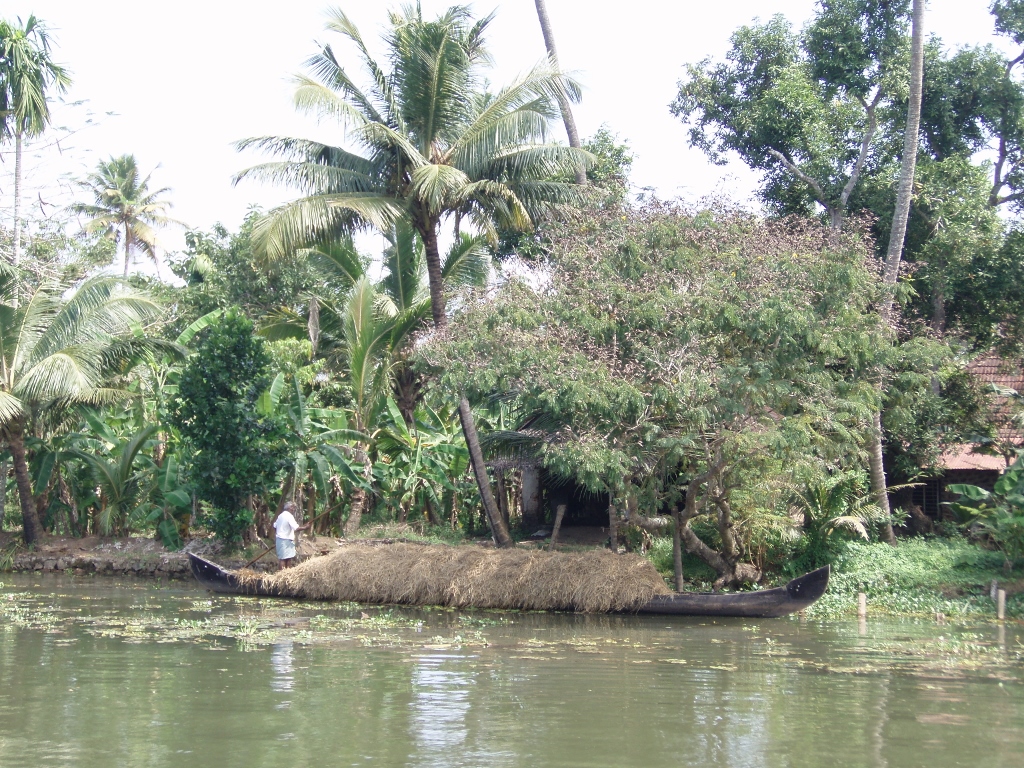 Boats are not only for tourists; they are also used to transport some serious quantities of goods
Boats are not only for tourists; they are also used to transport some serious quantities of goods
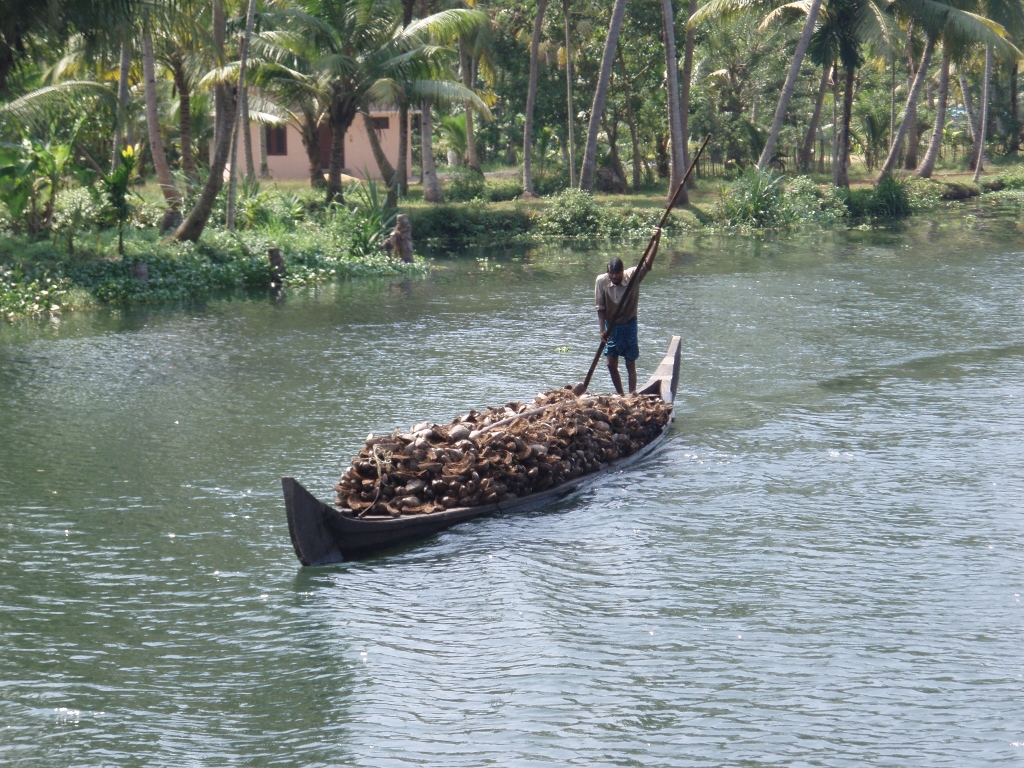 Smaller boats used for the transportation of goods always seem as if they are about to be inundated
Smaller boats used for the transportation of goods always seem as if they are about to be inundated
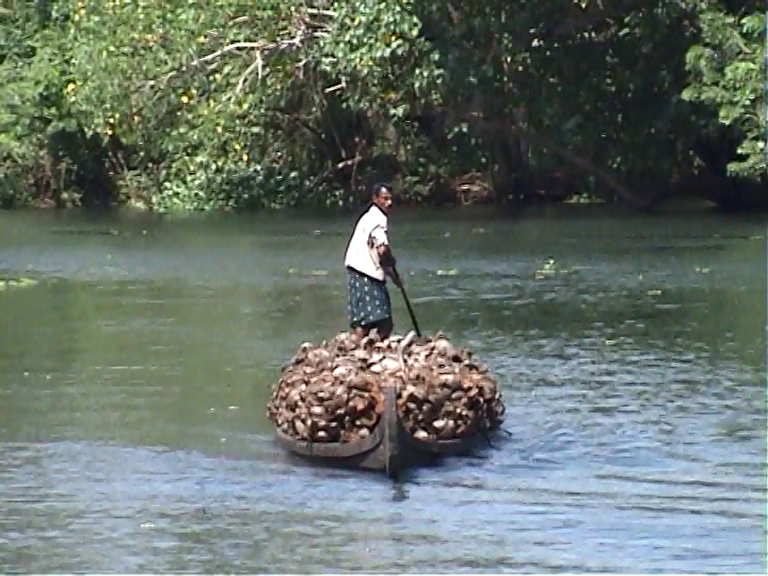 A boat transporting coconut husks
A boat transporting coconut husks
After the navigation along a wider water course, at some point our ship entered a somewhat narrower canal that was very nicely fixed up and with walled banks.
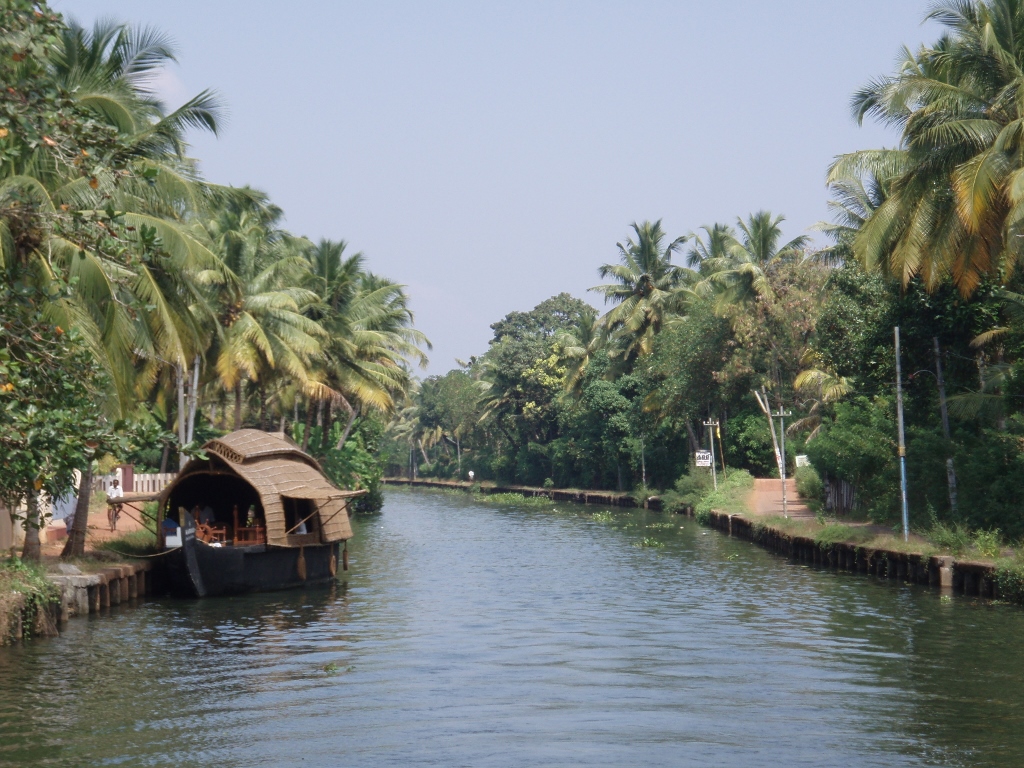 One of the canals in Kerala
One of the canals in Kerala
Along the way, in several places, we also saw incredible quantities of ducks. We did not quite understand why they were kept in such large groups and then we saw some local people like shepherds gathering them up on the water and then steering them via wide ramp into an enclosure.
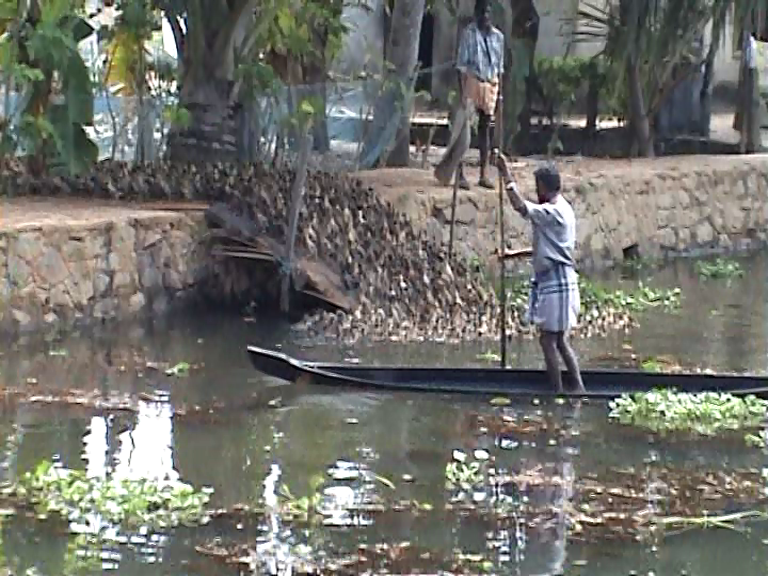 Duck shepherds
Duck shepherds
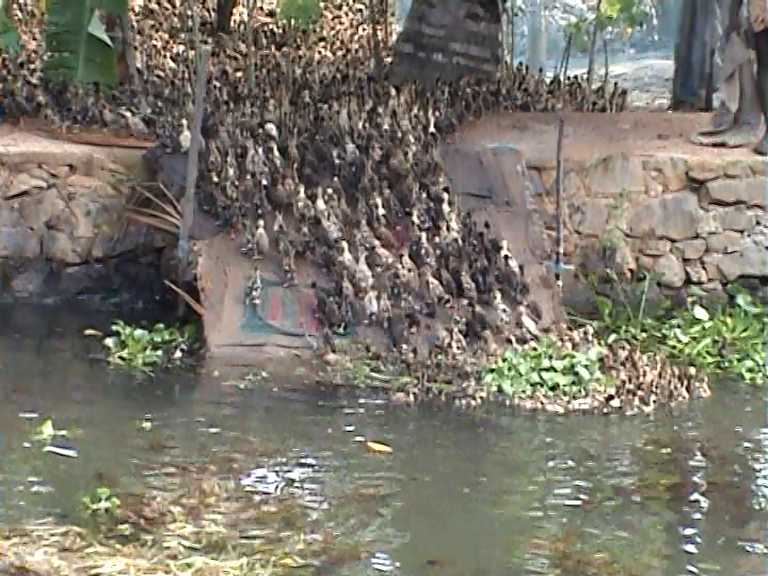 Duck ramp; take note of the upper part of the photo and the huge number of ducks
Duck ramp; take note of the upper part of the photo and the huge number of ducks
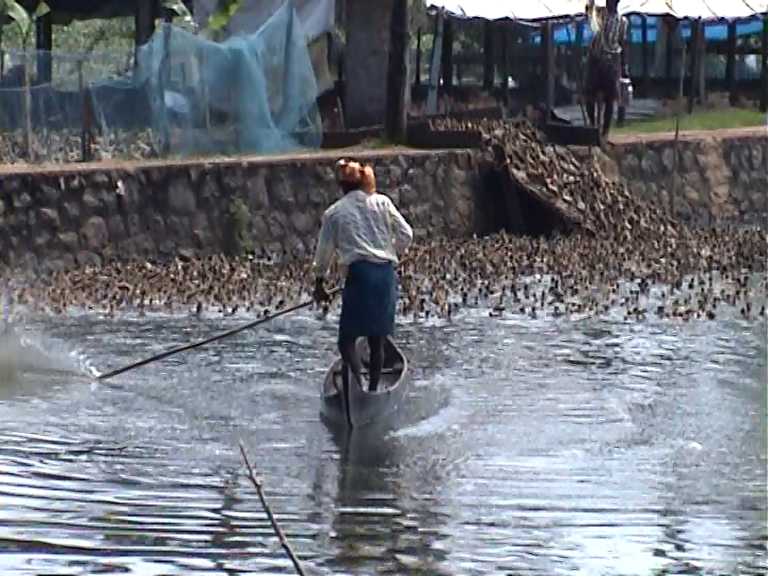 Duck shepherds
Duck shepherds
Although all of this was happening on a hot day, we actually did not feel the heat or the humidity because the ship kept moving, so this day was pleasant from several angles.
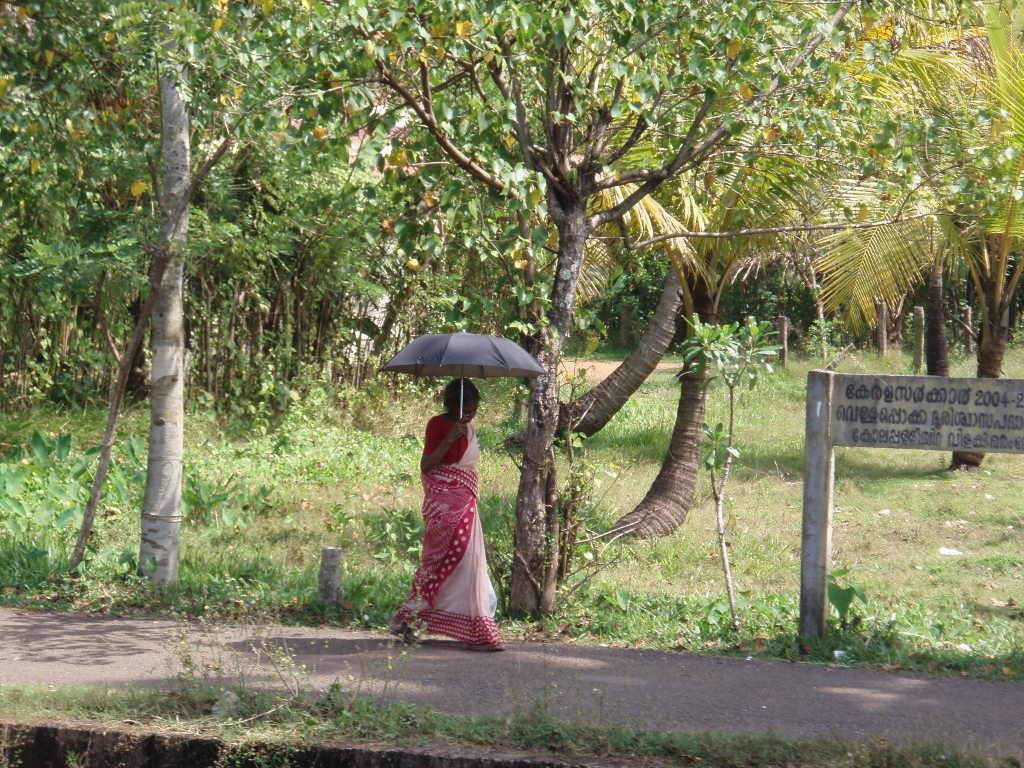 When there is no parasol, even an umbrella is fine
When there is no parasol, even an umbrella is fine
Along the way we also came across some other models of boats, such as these ones:
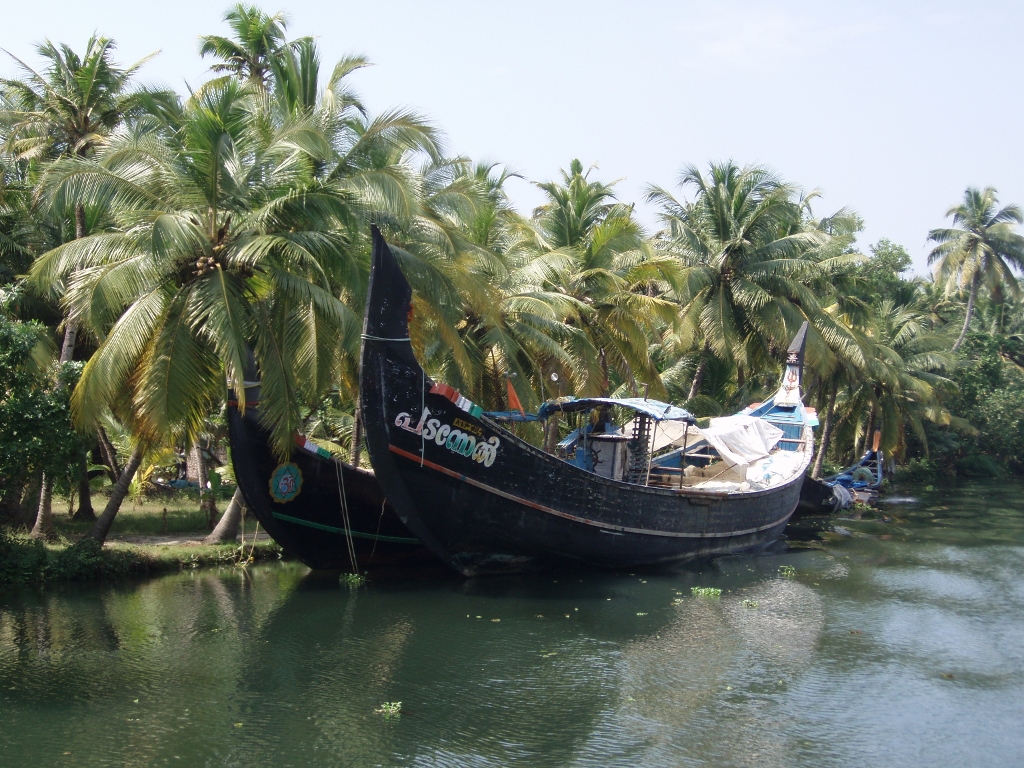 Boats in Kerala are quite diverse
Boats in Kerala are quite diverse
Still, regardless of the human activities and settlements beside the water courses, the main type of landscape consisted of coconut palms.
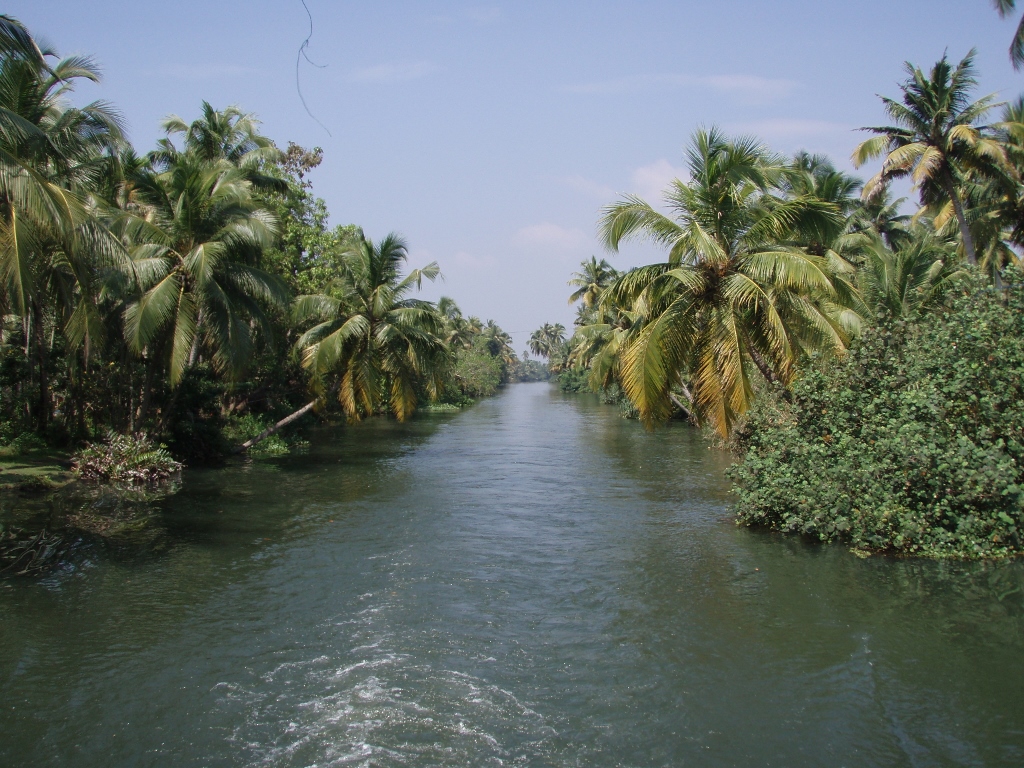 Abundance of coconut palms
Abundance of coconut palms
At some point the ship docked and we all went out in order to have lunch at a restaurant. Generally speaking, Kerala is working a lot on developing tourism and thus there are relatively a lot of restaurants, as well as hotels and resorts in this part of the state. The lunch was exceptionally tasty and as it is customary in India it consisted of different dishes, but we were supposed to eat with our hands that is also a frequent habit in India. In addition, all the food was served on banana leaves.
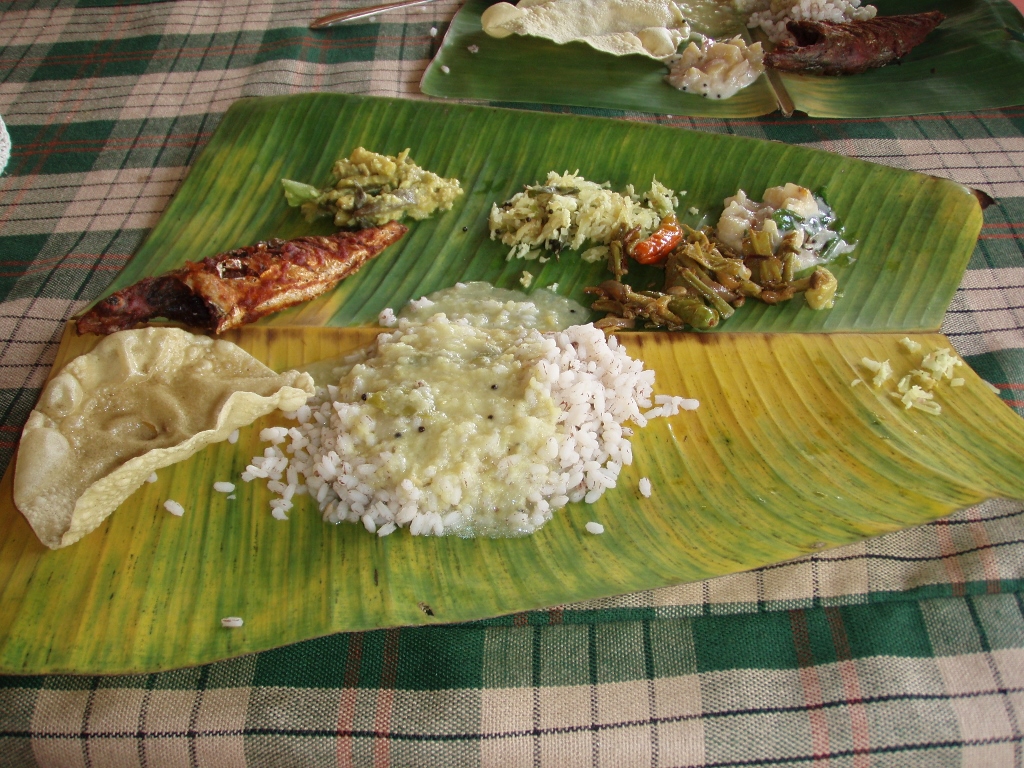 Here’s how to save on dishes and dish-washing liquids; completely ecological lunch
Here’s how to save on dishes and dish-washing liquids; completely ecological lunch
After the lunch break, we sailed again into a very wide section, that resembled a river, and there were installed poles there that suggested which directions were safe for sailing. Probably there are a lot of shallow sections and it would be easy for a vessel to run aground if the captain were not attentive. In addition, it got cloudy in the meantime and everything somehow seemed grey and gloomy.
There we also came across a large concentration of “Chinese fishing nets,” but these here also included small huts for the stay of the fishermen.
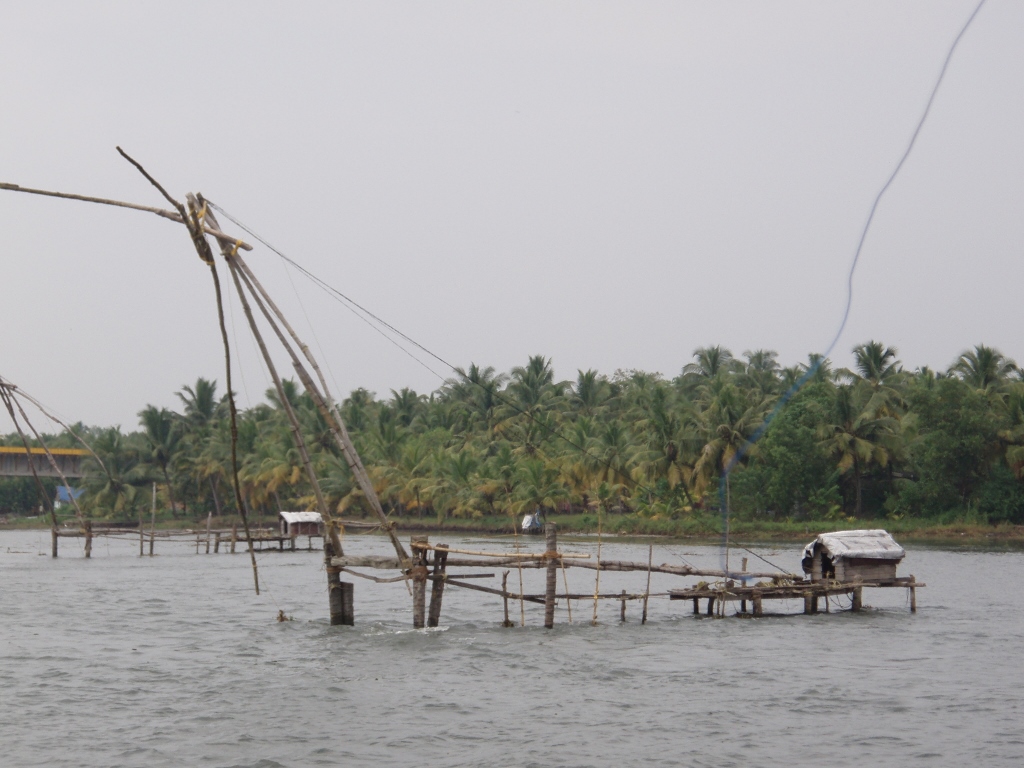 Chinese fishing net with a hut
Chinese fishing net with a hut
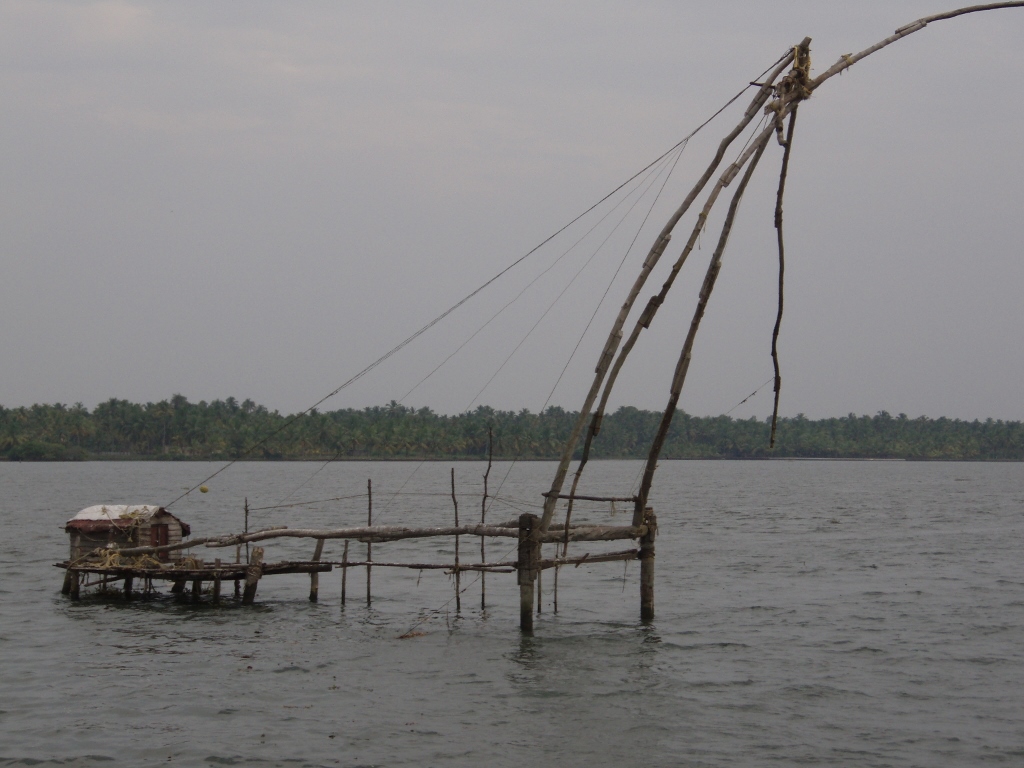 Chinese fishing net with a hut
Chinese fishing net with a hut
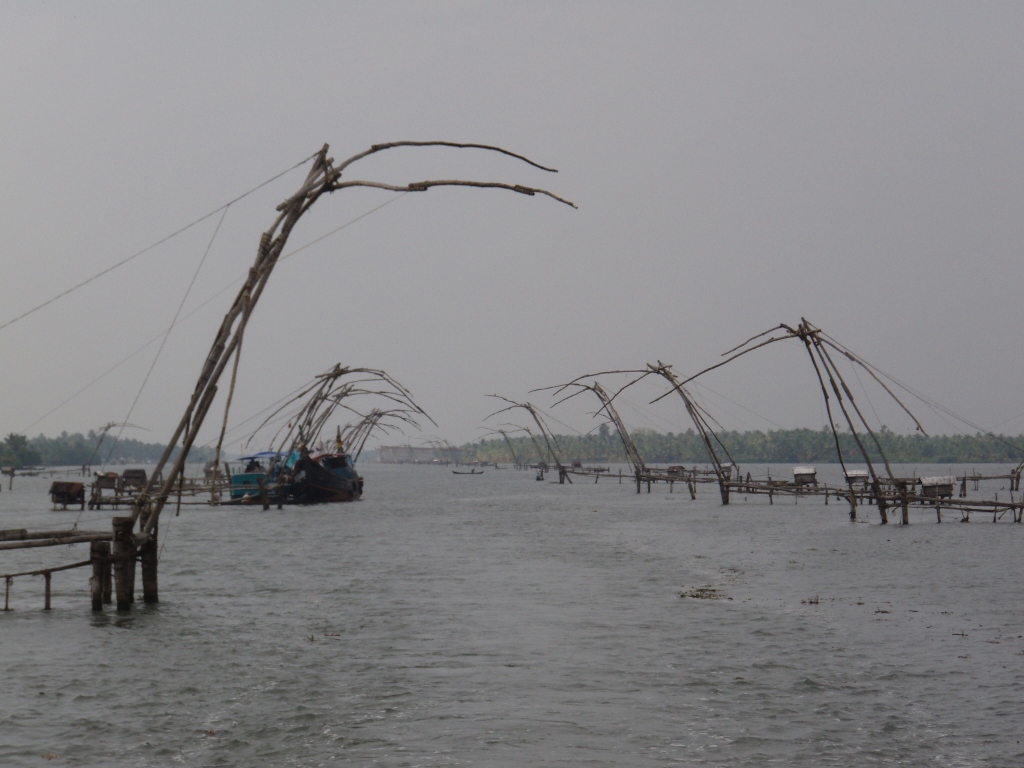 Passage through rows of Chinese Fishing Nets
Passage through rows of Chinese Fishing Nets
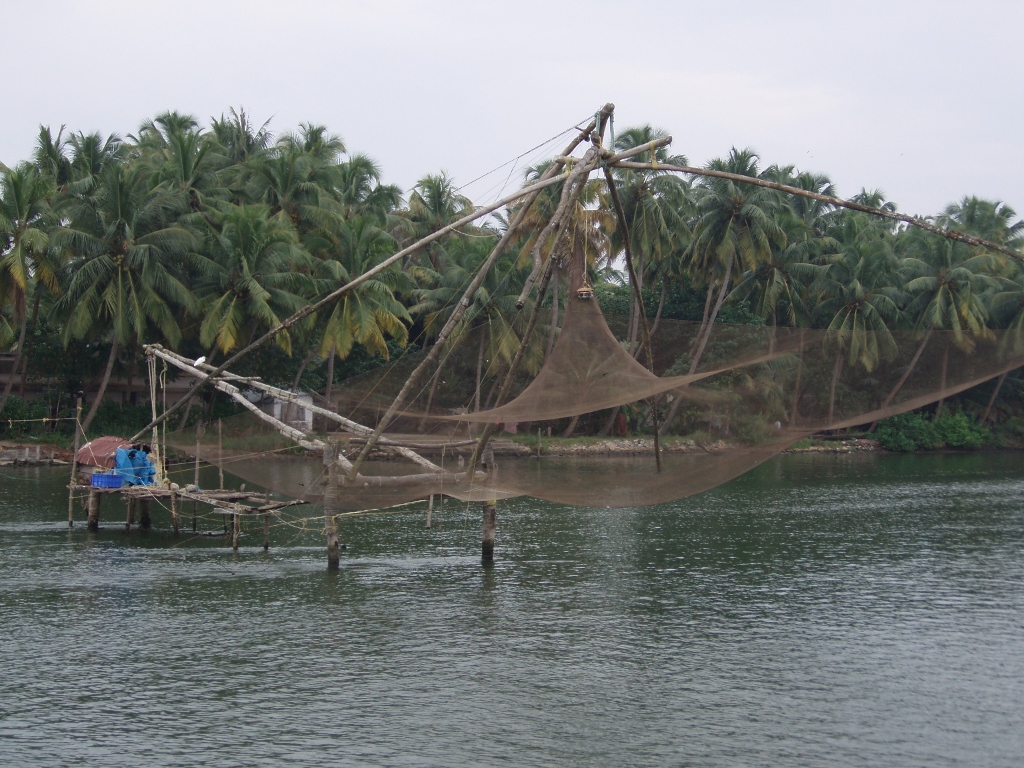 Chinese fishing net with a hut (note the round lamp that is hanging in the middle above the nets)
Chinese fishing net with a hut (note the round lamp that is hanging in the middle above the nets)
And then we came to some very unusual buildings that did not fit visually into the surroundings at all.
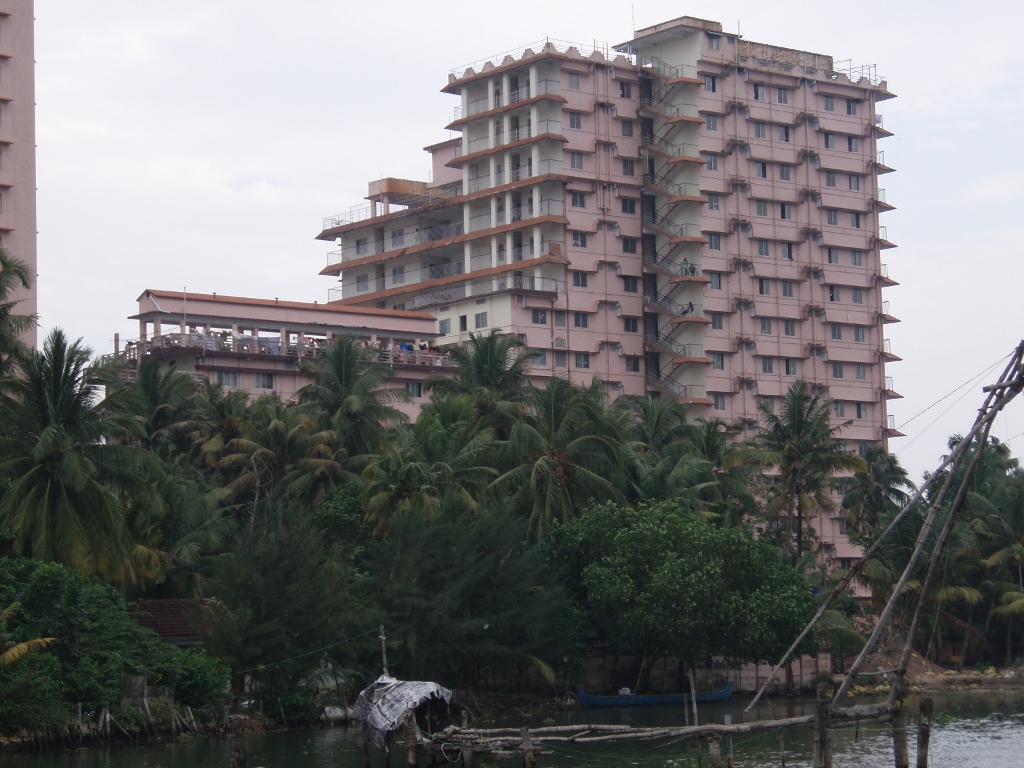 High-rises in the middle of rural Kerala
High-rises in the middle of rural Kerala
And yet, this was a very special and a very important place. This was the Amma or Mother ashram, the ashram of a female guru who is the embodiment of maternal love. During important feasts and celebrations, it is very crowded at the ashram since there are people coming from all parts of the world just to be hugged by Amma who in this way transfers to them huge quantity of love.
The ship line from Alappuzha to Kollam that we took also entailed a stop by the ashram in order for some people to come off the ship or for some others to embark here after some time spent at the ashram.
After this we had another break, but in order to have tea or coffee. This was in fact a shop by the canal we were sailing on that belonged to a village there and this mini-pier was right by a properly paved street.
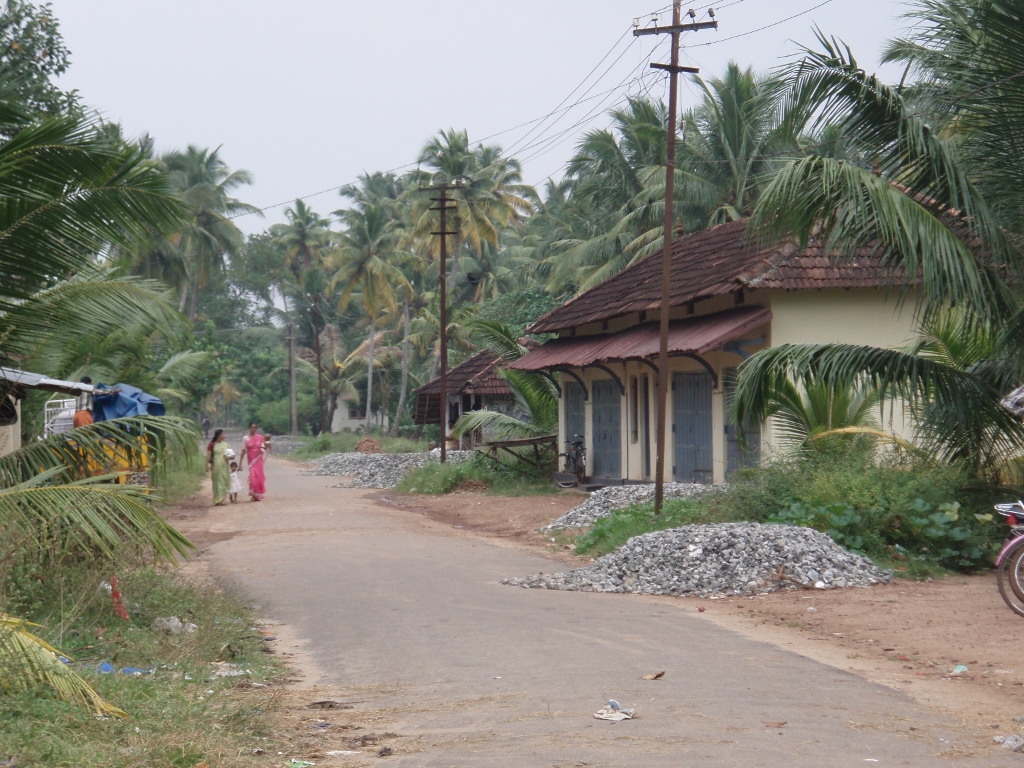 Main street in a village by the Kerala backwaters
Main street in a village by the Kerala backwaters
It was very quiet here and there were no crowds or noise that exist along road lines, but the public transportation did function nevertheless. Thus, while we were there, an auto rickshaw came in order for some things to be packed into it and to transport an elderly woman.
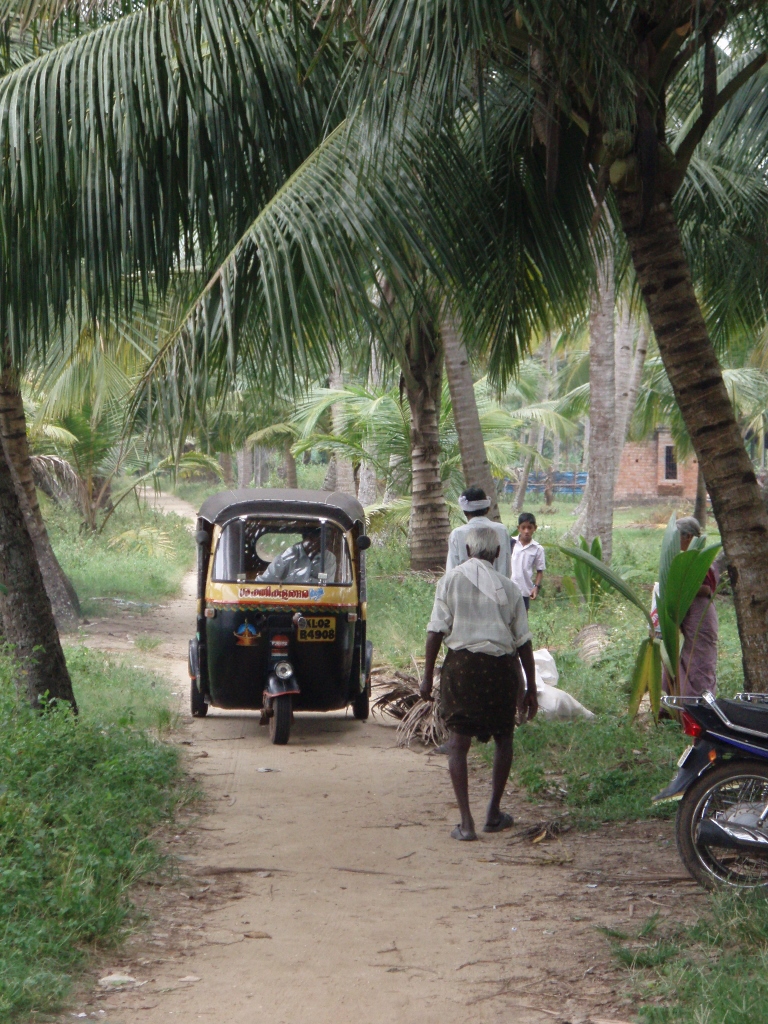 Public transportation in a village by the Kerala backwaters
Public transportation in a village by the Kerala backwaters
In the meantime it got really cloudy and even a few drops of rain flew here and there, but no more than that and a little later the clouds thinned out and we could see patches of blue sky again.
At some point the ship was moving along a relatively wide canal that was separated from the Arabian Sea by a very narrow isthmus.
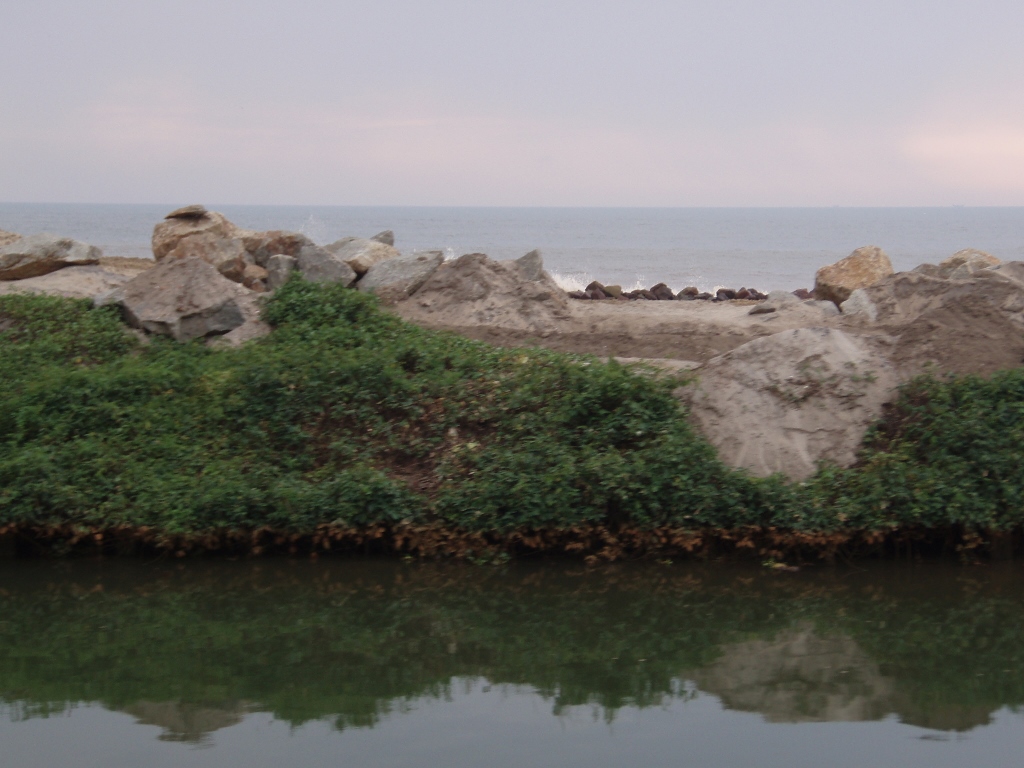 Kerala backwaters are in the foreground, while farther in the background is the Arabian Sea
Kerala backwaters are in the foreground, while farther in the background is the Arabian Sea
As the ship was sailing along this section, everything was resonating with smooth Indian music and then they told us it was the season of temples’ festivals, so several of the temples we were passing by had some celebrations.
Have a look at an edited video clip showing a day’s navigation along the Kerala backwaters:
Then we came across another wider part and there were again a lot of Chinese fishing nets, but since it was already twilight, some of those nets were now submerged, the lamps were turned on and it was typical fishing using light attractor.
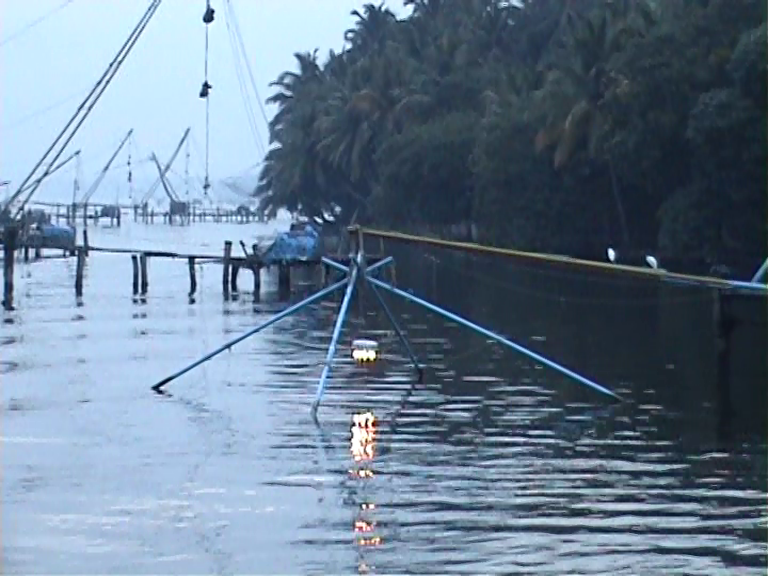 Nets are in the water, while the lamp is above them; it can clearly be seen here how the fishing technique works
Nets are in the water, while the lamp is above them; it can clearly be seen here how the fishing technique works
As we approached Kollam, all of a sudden we came across a very unusual sight.
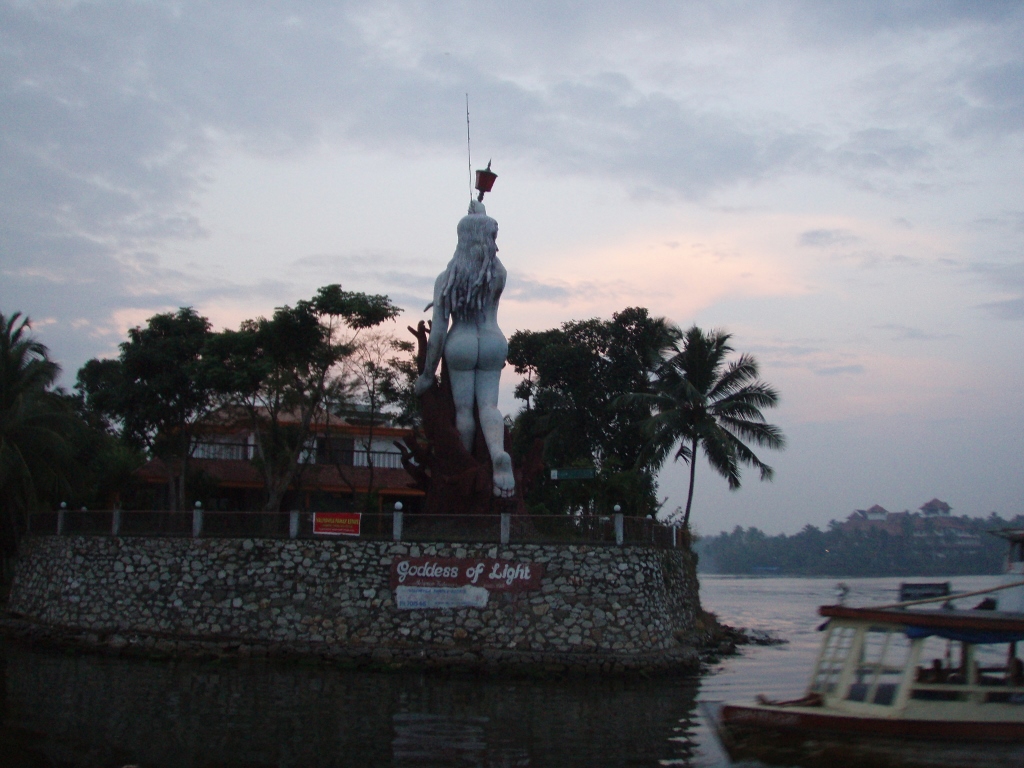 Goddess of Light
Goddess of Light
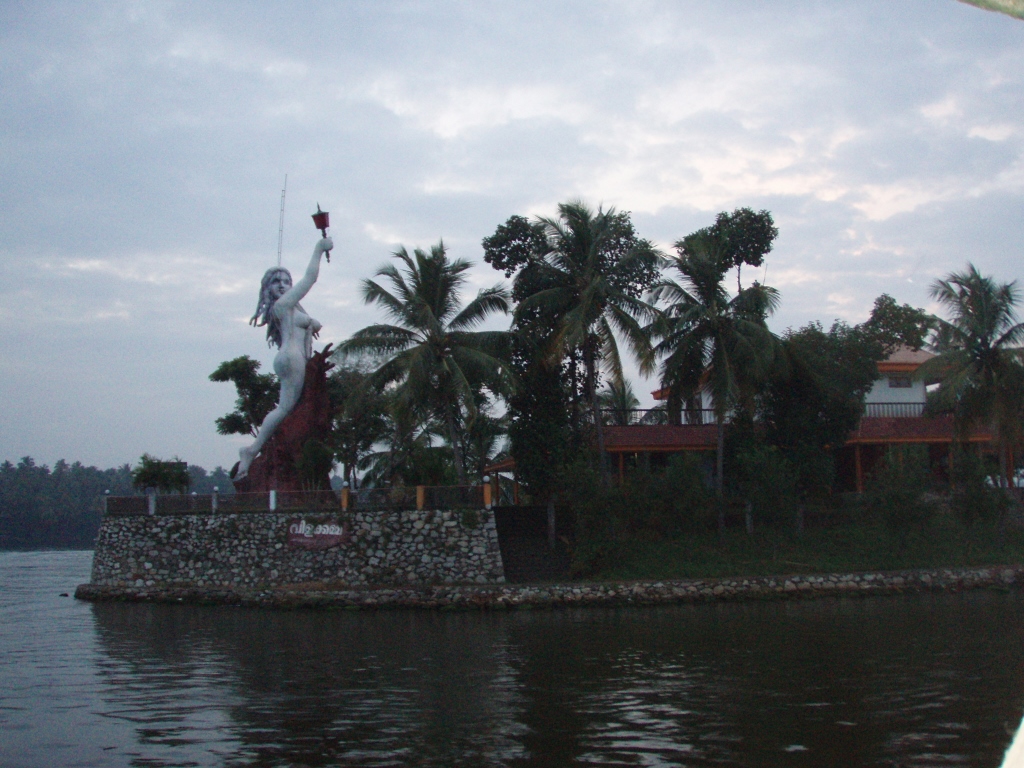 Goddess of Light
Goddess of Light
This was the Goddess of Light that belonged to a resort of a family estate Valiyavila. We were told that this was quite a good place for holiday and moreover the ship docked and a couple of passengers disembarked precisely here along with their luggage.
By the time we reached Kollam it was already dark and we got a dry-land vehicle to transfer immediately to Varkala that is some 30 km more to the south.
Varkala is a village in the federal state of Kerala that has become rather popular among visitors and apparently it boast one of the prettiest beaches. We had already decided to have another calm and relaxed day here.
To start with, we got up in the morning, got out of our bungalow and walked a little around the hotel/resort where we were staying. The place offered package deals, two or three weeks with ayurvedic food, massages, etc., and within the hotel, i.e., in one paved clearing between bungalows they had also had yoga lessons earlier in the morning.
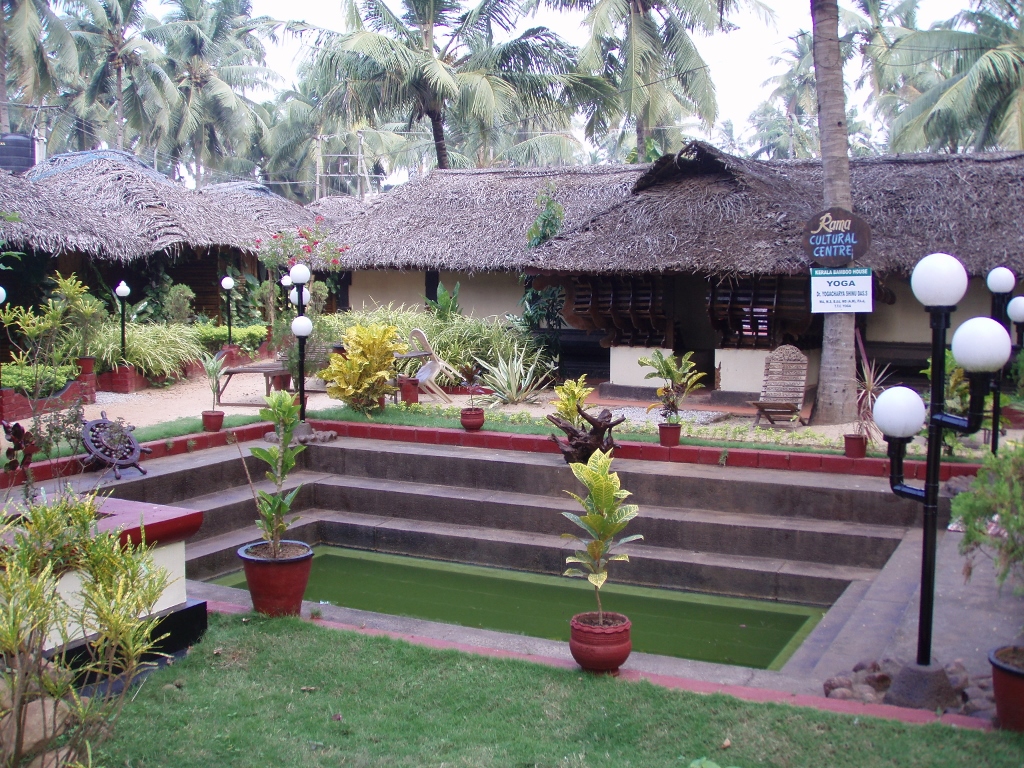 Part of our hotel in Varkala
Part of our hotel in Varkala
This morning in Varkala has remained in my memory as the time and place which for me were the most difficult in terms of the weather conditions. After that brief walk around the parts of the hotel that were around our bungalow, we returned to the room in order to have a shower. After this refreshment, we got out again, covered some 50 metres of flat surface to the path that runs parallel to the shore and then another 50 metres to get to a café where we were to have breakfast. While we were waiting for the coffee and the food, I was completely wet, my entire skin was moist, not as if I were perspiring and drops of sweat were forming. No. Simply the entire surface of my skin was uniformly moist as if I were walking through my own sweat. That was not a pleasant feeling for me and then I realised that I actually live in the climate that suits me much better. In Belgrade and in Serbia we have hot summers with temperatures regularly around 35 ºC or more, but the level of humidity is significantly lower and then it’s much easier for me to endure such heat.
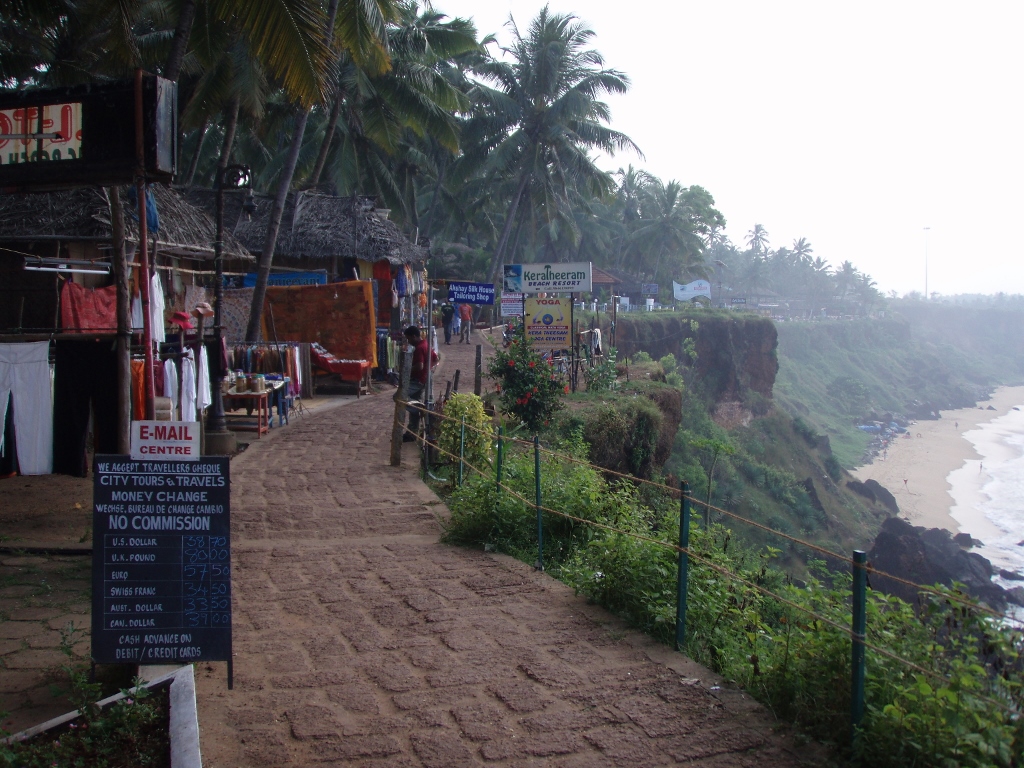 The path that follows the line of the shore in Varkala
The path that follows the line of the shore in Varkala
As I’ve said, Varkala is said to be one of the prettiest beaches in Kerala, but that does not mean that it is suitable for swimming. On the contrary, there are some very strong currents here and yet the entire place is still very touristic and beside the path that leads directly along the cliff there are numerous hotels, shops, restaurants and cafés, resorts, shops, restaurants and cafés, and then same more shops and restaurants and cafés. The main merchandise on sale here includes textiles, jewellery and different souvenirs.
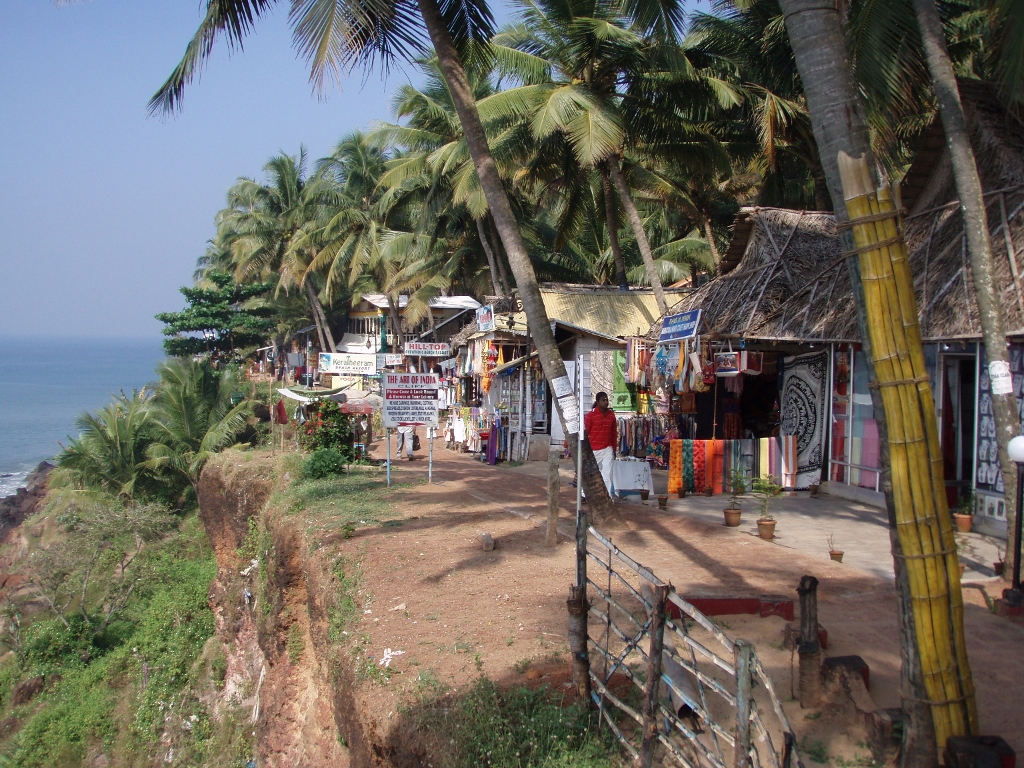 Shops beside the path that follows the line of the shore in Varkala
Shops beside the path that follows the line of the shore in Varkala
However, we decided to walk a little towards the village since we wanted to find a post office to send some post-cards (do you remember post-cards?). There we came across a tank that belongs to a nearby temple, but like in some other places this one is also used for the bathing and refreshing of local residents.
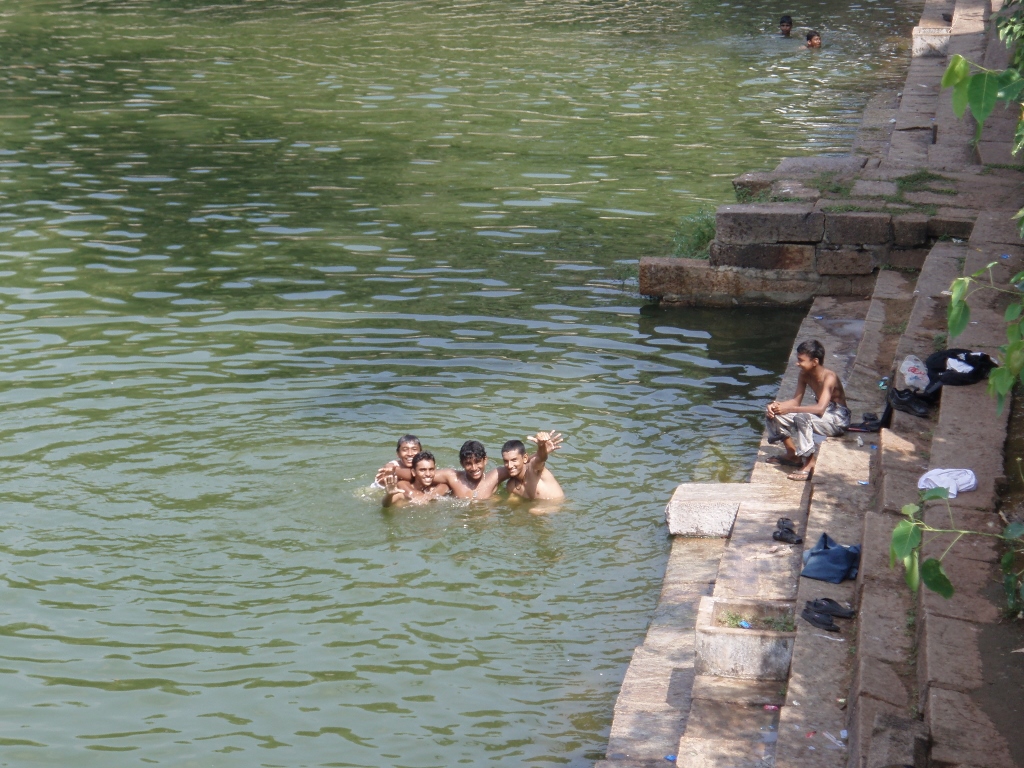 Joyful young men in Varkala
Joyful young men in Varkala
Like the previous day when we sailed along the backwaters of Kerala, here, too, these young people waved to us joyfully and we certainly waved back. I found it actually wonderful to see that even after so many years of tourism and tourists, these people here still rejoice in other people and greet them with this waving. I really love this almost innocent joy of Indians and I always find it very hard when I read about some beastly gang-rapes which unfortunately all too frequently come up to the surface as the news from this otherwise magnificent country. On the other hand, as my granny used to say “There are all sorts of things in God’s garden” and this applies to India as well. There are so many Indians, well over a billion, and it is therefore normal that among the huge number of wonderful people there are also some bad seeds.
We also took this opportunity to buy some fruits and I can just mention that regardless of the exotic appearance and the sweetness that comes almost automatically with the natural ripening, I found the red bananas a little less tasty and sweet than the small yellow ones. These colours that I’m mentioning here refer, of course, only to the skin – inside they are all of the same colour.
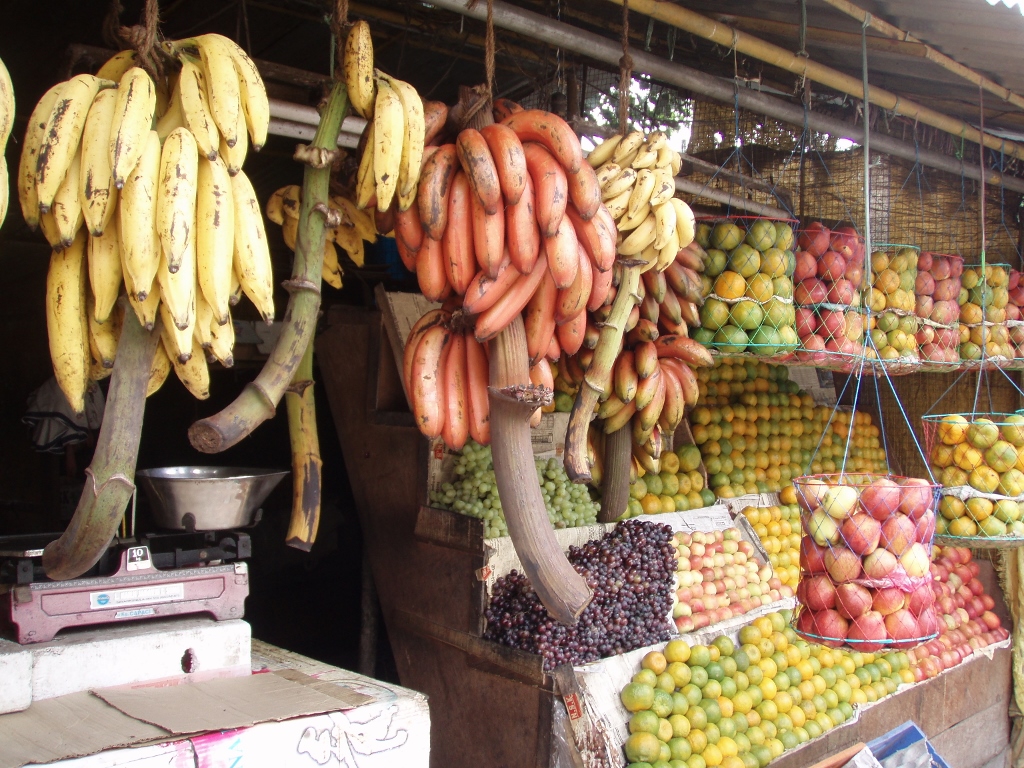 Fruit stand in Varkala
Fruit stand in Varkala
After this we returned to the line of the land, first walked along the cliff and then we descended to the beach where this was feasible. At some point we decided to go for a manicure/pedicure and henna tattoo on one hand and later we both agreed that this was the stupidest thing we did during the entire journey. We wasted too much time and it was absolutely not worth it. Of course, you cannot get the time back.
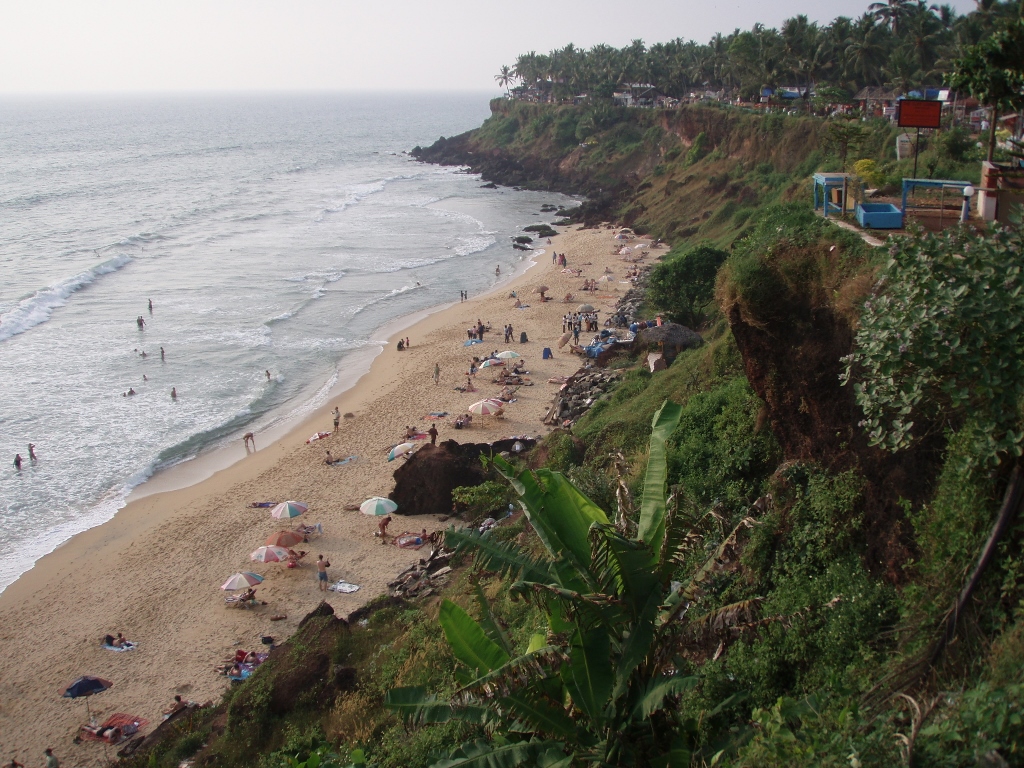 A part of the beach in Varkala
A part of the beach in Varkala
Later we went back to the path that leads beside the cliffs and we went to the other side towards Papanasam Beach. This is also a holy beach and a lot of Hindus come here in order to bring offerings for their loved ones who have passed away.
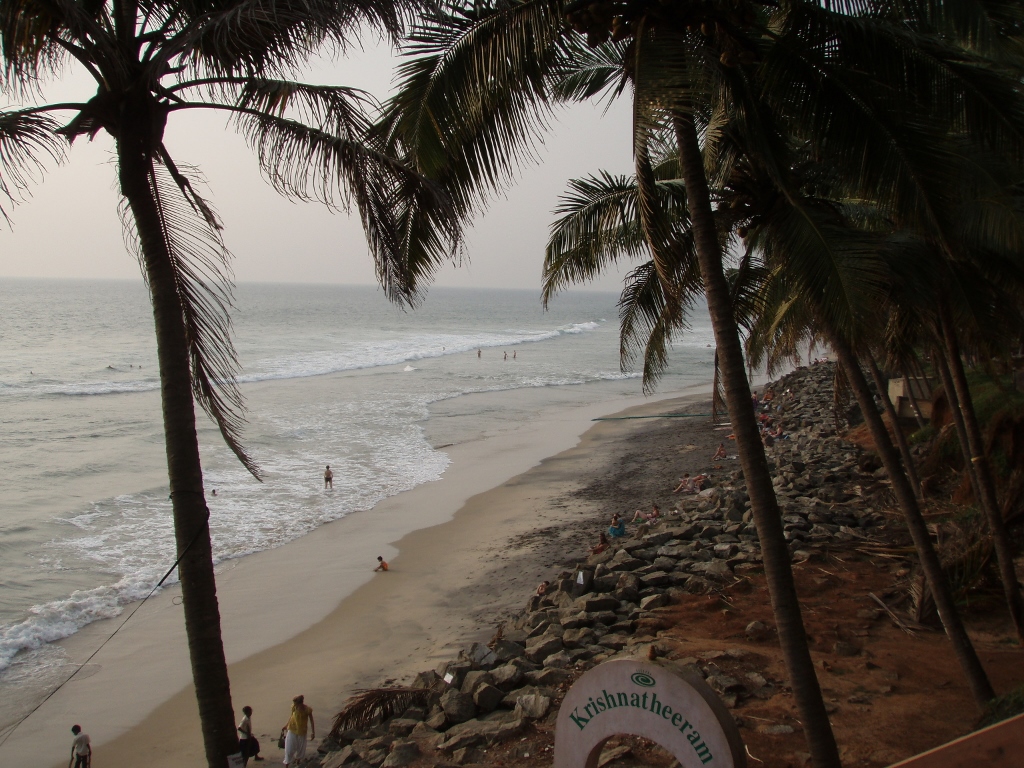 Papanasam Beach
Papanasam Beach
Some more walking along the shore and taking photos and we were ready for one more shower, followed by dinner.
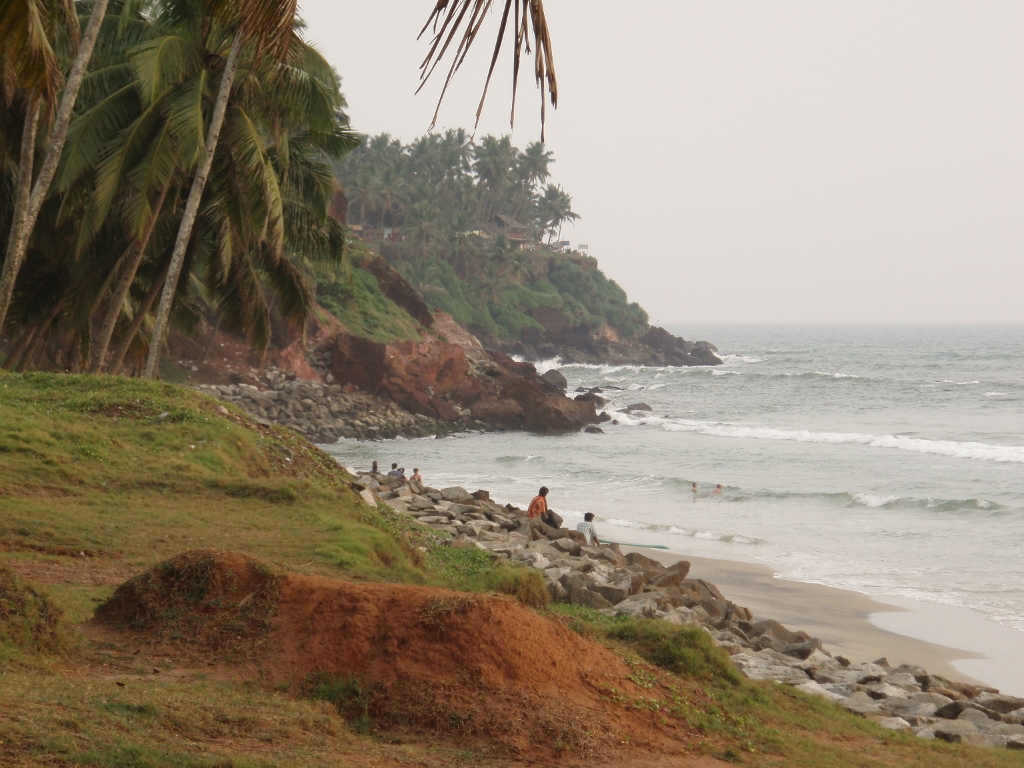 Papanasam Beach
Papanasam Beach
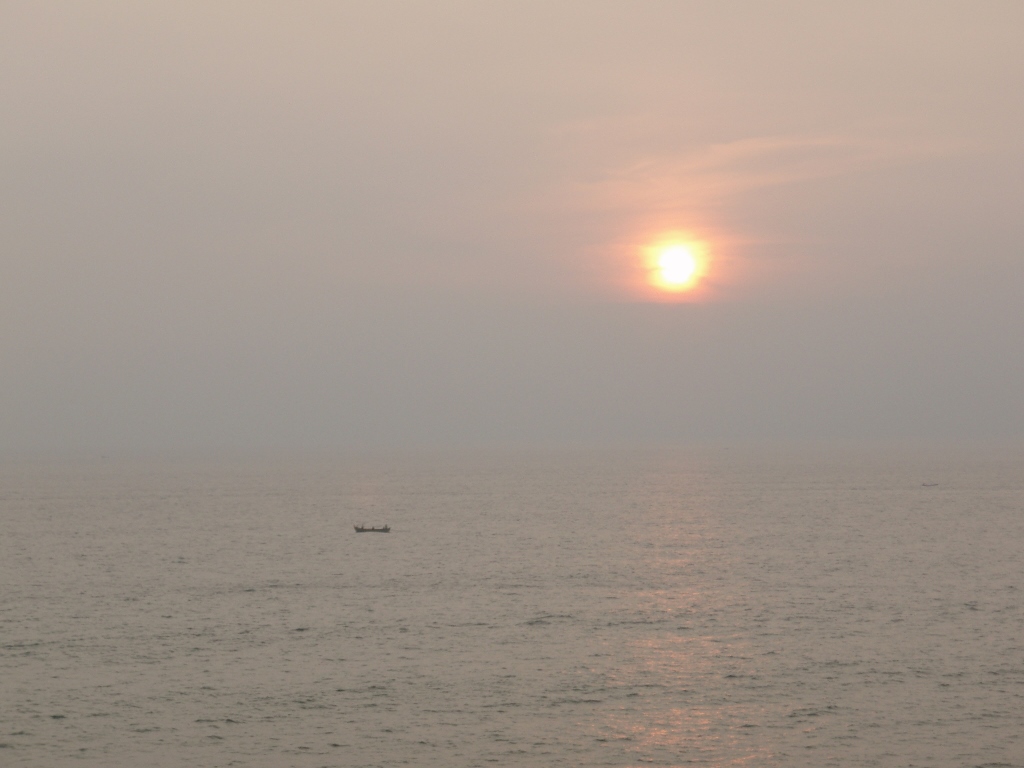 Arabian Sea
Arabian Sea
In the evening we went for fabulous dinner where we ate giant tiger prawns (Penaeus monodon) and also had an opportunity to see a tandoor oven from up close. This is a large, deep pot made of clay in which you put a thick layer of charcoal embers and then meat hung on metal rods is fitted into the pot after which it is baked in the hot air. These tandoor ovens can also be used to bake breads using a special technique by which breads are stuck to the sides of the oven.
Very much pleased and pleasantly full we went back to our bungalow for the night. The following day we were moving to yet another Indian federal state. It was Tamil Nadu.